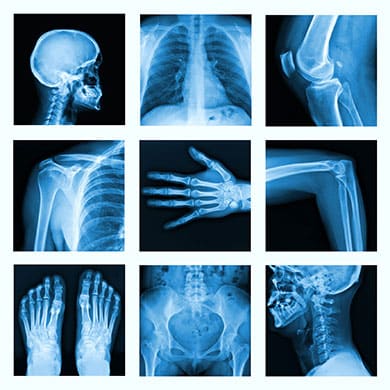At a glance
- We are all exposed to ionizing radiation every day from the natural environment.
- Added exposures, from procedures such as medical imaging, can lead to an increase in our cancer risk later in life.
- X-rays usually use the least amount of radiation compared with other imaging tests.

The basics
You likely have had x-rays before. X-rays, formally referred to as radiographs, are common imaging procedures ordered by healthcare providers and dentists. X-ray machines pass x-ray beams (a form of ionizing radiation) through a part of the body to produce images. These images allow healthcare providers and dentists to see if there are problems, like a broken bone or a cavity.
Healthcare providers and dentists both use x-rays for your care. A healthcare provider may recommend x-rays to look for bone fractures, tumors, injuries, or signs of pneumonia in the lungs.

Dentists take x-rays to check for cavities or other dental problems. How often you need x-rays at the dentist depends on your dental health history, risks or symptoms, and your age. Children typically need x-rays more often because their teeth and jaws are still developing.
What to expect
Before the x-ray
- Make sure to let your healthcare provider or radiologist (medical professional specially trained in radiation procedures) know if you are pregnant or think you could be pregnant.
- You may be asked to remove anything metallic you are wearing like jewelry or clothing with zippers.
During the x-ray
- You may need to stand or lay down in a certain position or angle while the image is completed.
- For some dental x-rays you will be asked to bite down on a device that is placed in your mouth in a few different positions.
- Depending on the part of your body being x-rayed, you might be provided with a lead covering to prevent radiation from reaching other parts of your body.
Your healthcare provider or dentist should recommend an x-ray when they believe that the benefits to your health outweigh any risk. Talk to your healthcare provider or dentist to decide when x-rays are the best choice for you.
Medical and dental x-rays use very small amounts of radiation. They only expose the smallest area of the body needed to get the image to check for a health concern.
Your risk of any long-term effects of ionizing radiation from x-rays depends on the part of the body being x-rayed. Some organs or tissues are more sensitive than others. Your risk is also based on the amount of radiation exposure. This may include the total number of medical procedures using radiation, over time.
Resources
FDA
Image Gently
U.S. Environmental Protection Agency (EPA)
- RadTown USA Medical X-Rays
- Radiation Protection Guidance for Diagnostic and Interventional X-Ray Procedures
U.S. National Library of Medicine
